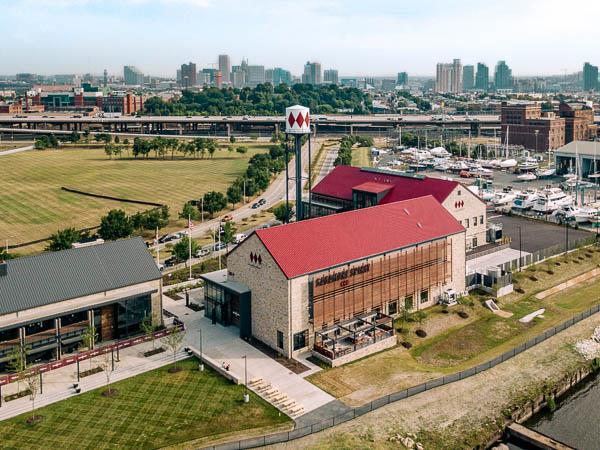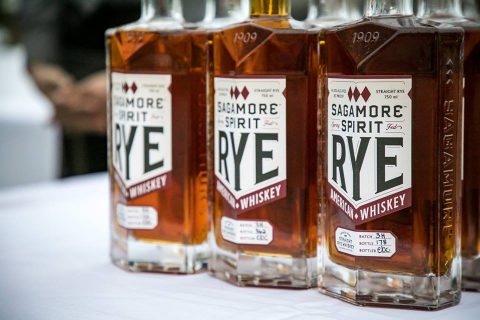The state of Maryland has a rich history of producing whiskeys, specifically rye whiskeys. By 1912, Maryland had more than 40 distilleries.
During World War II, distillers slowly started to convert their plants from spirits to ethanol to support the war efforts. Then after the war, very few converted back. It seemed that Maryland rye whiskey would fade into history after the last rye distillery closed its doors in the early 1970s.
In the mid-2000s, rye whiskey started to regain fans and new distilleries were beginning to pop up around the country.
Enter Brian Treacy. The idea for Sagamore Spirit was first conceived in 2012, with the brand officially launching in 2016 on his five-acre waterfront distillery in 2017.
The name comes from a thoroughbred horse racing farm, Sagamore Farm, 22 miles from the Port Covington distillery. That farm was built on a shelf of limestone that produces some of the highest quality water in the mid-Atlantic region. That water is an integral part in Sagamore’s ingredient list for their rye whiskey.

Sagamore makes their Maryland rye whiskey a bit differently. They start with two whiskeys, one with a high rye mash bill at nearly 100%, then another with a low rye mash bill just over 50%. They age them separately then later blend them together to create a complex, flavorful and approachable whiskey.
This unique blend yields flavors and spices of a high-rye, yet it’s balanced out with the use of corn on the mash bill of the second whiskey and the limestone water from the farm to cut the spice.
Their expressions are different from other whiskeys, and different from other rye whiskeys, because it’s Maryland rye whiskey. They want to inspire a global passion for Maryland rye whiskey. In fact, that’s their mission statement.
We spoke to Sagamore Spirit’s President Brian Treacy about how he got started, the history of Maryland rye whiskey and what we can expect out of Sagamore Spirit in the future.
So how did you get into the spirit business?
Brian Treacy: You know, I was really fortunate. We have two main investors in Sagamore Spirit and they had the vision for it, but they have a lot of other great things going on. They basically were just looking for somebody who had that entrepreneurial spirit.
I had talked to them before and we’d kick around a lot of ideas because they are just two really great entrepreneurs. But they said, “If you ever have something really off the wall, we’d be interested in hearing it.”
They called me one day and asked, “How about a whiskey distillery?” And I was like, “Now I’m listening.”
How's it been growing a brand that has some history, but to consumers is kind of brand new?
There are not many people telling the Maryland Rye story, right? It's interesting because it's a heavy lift.
We get out there in the field and it’s all about how many people can you talk to in a day. How many people can you find that are willing to listen to our story? Because it’s a really good one.
Do you feel your role is kind of dual purpose? You have to educate people about Sagamore and then also provide a history lesson on Maryland Rye?
"Who is Sagamore?" That's the number one question. Number two is typically, “What is rye?” A lot of people still want to know, and then they're scratching their head saying, “Maryland, really?”
Maryland has a great history of distilling rye whiskey, but it's also a different rye whiskey. So now I not only have to tell the rye whiskey story, but I also include why Maryland's rye whiskey is different than other rye whiskeys.

How do you balance it when you only have a short period of time? Do you lead with the Sagamore story or the category history and education?
You’ve gotta lead with Sagamore. I think it’s extremely important to have a solid two minute elevator pitch, so I can kind of get the entire story in there when introducing the brand.
My elevator pitch is essentially: Maryland had a great history of distilling. We had 44 distilleries in 1910 and kept making rye whiskey all the way through Prohibition. Switched over to ethanol to support the war. Sagamore is here to bring it back.
If I can leave them with one thing, it's that Sagamore’s whiskey is unique. I think that leaves people wondering and wanting more.
When you are pitching this to bartenders who might know a little bit more, how does your story change for them?
I usually let them come to me with what interests them the most. They all seem to have a little bit different interests. Some people want to know about your barrels more than other things or our aging techniques.
They all want to know your mash bill, obviously. I think people are taken aback that instead of just distilling one single mash bill, and just dumping it all the time, that we’re actually blending two straight rye whiskeys.
Where did those two mash bills come from originally? Trial and error?
It was. We know how much rye really is in there at the end of the day and we tried a lot of mash bills and they just were different. We felt like we got a lot more complexities and we got what we thought in our understanding of what Maryland style rye is.
You got that rye flavor, you got that rye spice, but there is something floral and sweet about ours as well. You are not getting a typical rye. I think that's where that balance of the two mash bills come from.
Then as time goes on with our LTO's (limited time offers) and so forth, we got two mash bills now to play with which is pretty fun.
As far as LTO's, you seem to be concentrating a lot on wine barrel finishes. Is that a conscious effort?
We did a moscatel, and we did the double oak in a sense. It’s not totally a double oak, but it's an interesting finish. We've done a cognac finish, too. We go out on the hunt with no specific barrel in mind, we just go find what we think is the best one out there.
Who is the one looking for those?
We've got a couple of guys on the team that have a great nose for it, with a great palate and a really good understanding of how our whiskey will interact with any type of barrel.
Max, Christopher and Ryan, and several others, just have a talent for going out there and putting a nose in every single barrel that we pick and just knowing the best ones to choose.
We don't just say, “send us barrels.” They literally go to the source and bring us barrels. Whatever they think is the best they can find during that time frame is what we roll with.
What’s next for Sagamore?
We've got a lot of stuff in research and development. So, if you go into our warehouse, you're going to see five, six, seven types of barrels. You’d see the names on them and be like, "Oh wow!"
We'll see where this goes. Because maybe the whiskeys are great by themselves, maybe they are great blended with a couple others. It's fun and finishing it seems to be popular, so we’re having fun with it.
The wine finishes complement the rye really well and we find it ends up being a really nice balance.